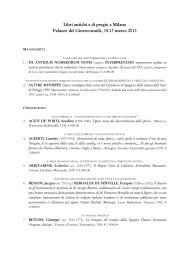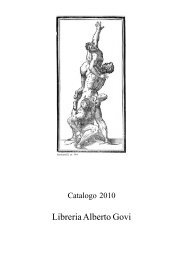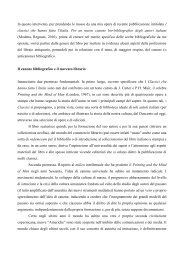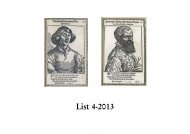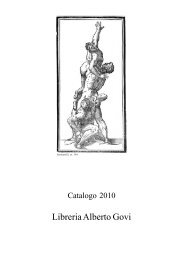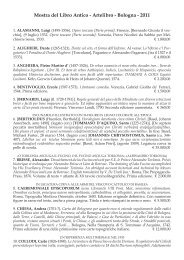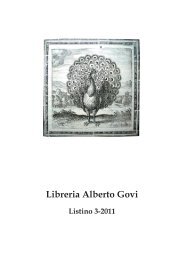teachers and show no evidence of borrowing from Erasmus’ recent work” (R.M. Douglas, Jacopo Sadoleto, Cambridge,MA, 1959, p. 75).“Il cardinale Jacopo Sadoleto, uno dei vescovi che cercarono un punto di incontro col mondo protestante,per cui ebbe rapporti con il Melantone, e fu accusato di aver soverchie simpatie per la Riforma, nel suo trattatosull’educazione… si mostra profondamente convinto di un possibile accordo fra educazione umanistica e cristianesimo:gli studia humanitatis fanno l’uomo saggio e morale, aiutandolo a scoprirsi “naturalmente cristiano”. Ifanciulli, dopo un’infanzia affidata alla famiglia, e guidata dal padre, apprendono sotto i maestri grammatica e retorica,poesia e musica, aritmetica e geometria. Completano il sapere con la filosofia, e non con l’arida sofistica degliscolastici, ma con la saggezza morale, la profondità logica e l’altezza metafisica di Platone e d’Aristotele. Avviarei fanciulli al bene è facile, ‘perché quell’età non pecca per malizia”, anzi è fondamentalmente buona; per questoil bambino non va mortificato, non va reso “austero e selvaggio, ma lieto e affabile… Stia con i suoi pari, corra,salti, si dia ai giochi, e specialmente a quelli che esercitano il corpo; e danzi e rida, qualche volta abbandonandosiall’allegria’. Nel S. veramente si conservano alcuni degli aspetti più fecondi dell’umanesimo, connessi con una federeligiosa sincera ed aperta” (E. Garin, L’educazione in Europa, Bari, 1976, pp. 202-203).Jacopo Sadoleto, a native of Modena, rapidly rose in the new bourgoisie, but his origins remain obscure.We know of him first as a student of civil and canon law at the University of Ferrara, where he soon received praisefrom his masters and from Duke Borso d’Este. He was a jurisconsult in Modena at the time of his marriage to FrancescoMachiavelli, and taught at Pisa before returning in 1488 as professor of law in the University of Ferrara on theinvitation of Duke Ercole I. At this time Sadoleto first met the gifted Venetian humanist Pietro Bembo. Their friendshiplasted for fifty years despite widening differences of temperament, literary taste, and sense of vocation. In1498/99 he left Ferrara for Rome, where his first patron was Cardinal Oliviero Carafa. Here he met with humanistfriends like the younger Beroaldo, Castiglione, Paolo Giovio, Blosio Palladio, Andrea Navagero, Mario Maffei andmany others. The course of his career in Rome was set in 1513, when he and Pietro Bembo were appointed to theApostolic Secretariat by Leo X. To the several benefices, canonries, and pensions he received, the pope added the dioceseof Carpentras, in the papal state of Venaissin in Southern France, in 1517. He was summoned to Rome by PaulIII, to assist in preparation for the council. He emerged as a radical critic on the commission of ecclesiastical reformwhen its Consilium de emendanda ecclesia was presented to the pope. While strongly supporting the convocationof the council, Sadoleto undertook his own efforts at conciliation with the Protestants, hoping, like Erasmus, topromote rapprochement through moderates on both sides. But his conciliatory letters to Melanchthon and othershad only the effect of enraging the hard-core Catholic conservatives in Germany. In 1542 Sadoleto was recalled toRome to work for the council, now to be held at Trent and which opened at the end of 1545. He was assigned to thespecial commission on conciliar affairs. From his votes there it seems clear that no other member was less partisan,less attached to national interest, or more independent of the pope’s dynastic ambitions than the bishop of Carpentras.Sadoleto died on October 18, 1547 at the age of seventy and was buried in San Pietro in Vincoli. His remainswere transferred in 1646 to the cathedral of Charpentras, which he had helped to build (cf. Douglas, op. cit., passim).Edit 16, CNCE32330; L. Carpané, I Nicolini da Sabbio. <strong>Catalogo</strong> breve delle edizioni a stampa, Venezia, 1521-1551, in: “Ilmestier de le stamperie de i libri. Le vicende e i percorsi dei tipografi di Sabbio Chiese tra Cinque e Seicento e l’operadei Nicolini”, a cura di E. Sandal, Brescia, 2002, p. 167, no. 25. € 1.500,00in praise of women’s superiority13) AGRIPPA VON NETTESHEIM, Heinrich Cornelius (1486-1535?). Declamatione de Henrico CornelioAgrippa del sacramento del matrimonio.(bound with:)-.-.-. De la nobiltà, e preeccellentia del feminile sesso a la Signora Margarita Augusta, Principe d’Austria, e diBorgogna. [Venezia, Venturino Ruffinelli, 1535 ca.].Two works in one volume, 8vo; modern vellum; (12, the last is a blank) ll. + (24, the last is a blank) ll. Title-pageswithin an illustrated woodcut border on black criblé background, featuring musical instruments, grotesque figures,and mermen. Three white-on-black illustrated and foliated initials. Text printed in dark roman type. A very goodcopy.VERY RARE FIRST ITALIAN EDITIONS of Cornelius Agrippa’s Libellus de sacramento matrimonii and De nobilitateet preeccelentia foeminei sexus. The first work was composed around 1526 and published with a dedication toMarguerite de Navarre in an undated edition with Latin and French text, which has been demonstrated to havebeen printed in 1526 (cf. A. Prost, Corneille Agrippa, sa vie et ses oeuvres, Paris, 1882, II, p. 506). The De nobilitate, dedicatedto Margaret of Austria, although written in 1509, was edited for the first time in Antwerp in 1529 togetherwith other minor texts, among which also the De sacramento matrimonii.The De nobilitate had a great success and was reprinted and translated several times. The first two Frenchtranslations, one by Galliot du Pré, the other by an uncertain author, were given to press in 1530 respectively atParis and Antwerp. The German version of Johann Herold appeared in Frankfurt in 1540. Two years later wasissued in London the English translation of D. Clapam. The work had also a great influence on those writers whowanted to contribute with new writings to the defense of women. Among them, François Habert published at Parisin 1541 Le Jardin de foelicité avec la louënge et haultesse du sexe feminine en ryme françoyse, admitting already in the title-pageto be in Agrippa’s debt. Not equally honest was Ludovico Domenichi, who in 1549 issued at Venice fromGiolito’s press a work titled La nobiltà delle donne, which is greatly based on Agrippa, and mentions its main source- 14 -
as secondary only.The present two editions bear no indications ofprinter, nor place or date. Edit 16 states that they wereprobably printed in Venice around 1530. The title-pageborder is very similar to that used by Cinzio Achillini, aprinter active in Bologna between 1525 and 1529, for anundated edition of Casio de’ Medici’s Cronache (see Edit16, CNCE9849) and for a Dioscorides edition of 1526 (seeEdit 16, CNCE17259). The same block was also used byBenedetto di Ettore Faelli for a 1532 edition of Fra Giovannida Fano’s Opera utilissima volgare contra le pernitiosissimeeresie luterane per li semplici. The drawing of the border hasbeen recently attributed to Amico Aspertini (cf. A. Emiliani– D. Scaglietti Kelescian, eds., Amico Aspertini, 1474-1552, artista bizzarro nell’età di Dürer e Raffaello, Milan, 2008,no. 147, pp. 328-330, by S. Urbini). The present border, ofthe same size and design as that of Achillini-Faelli, however,differs in the background, which is dotted rather thanhatched. The same border was used some years later bythe printer Venturino Ruffinelli, for instance in the editionof Canto primo del Cavalier del Leon d’oro he issued in 1538on behalf of Ippolito da Ferrara (see Edit 16, CNCE29851).Evidently the border is in this case the very same used inthe present Agrippa’s editions, since they share not onlythe same measures and ornamental motifs, but also someminor defects in the outside border. From Ruffinelli’s atelierseem appertain also some woodcut initials with vegetaldecorations which appeared also in the present De Nobilitateedition and, for example, in the edition of ZaccariaLilio’s Orbis breviarium, that Ruffinelli published togetherwith Giovanni Patavino in 1544 (see M. Sander, Le livre àfigures italien, Milano, 1942, 3977; and E. Pastorello, Tipografi, editori, librai a Venezia nel secolo XVI, Firenze, 1924, 17).The translator is unknown. A second Italian translation of the De nobilitate made from a French version andusually attributed to Angelo Francesco Coccio, was printed by Gabriele Giolito in 1544 and reissued in 1545 and1549. The Italian translation De sacramento matrimonii was apparently never reprinted. A comparison between thepresent translation of the De nobilitate and that published by Giolito, shows that the older version is, from a literarypoint of view, the less elaborated and faithful (e.g. some Greek and Hebrew words were completely omitted). “Acomparison between the preliminary materials of the two editions interestingly indicates the self-image Giolitowhished to fashion. Whereas the earlier translation clearly acknowledged Agrippa as the original author, and keptintact the initial dedication to Margaret of Savoy, Princess of Austria and Burgundy, Giolito’s translation made noreference to the author either on the title page nor in the main text. Similarly, the dedicatee’s name was eliminatedand Giolito dedicated the work to Buona Maria Suarda da San Giorgio, a noble woman from Monferrato, Giolito’shomeland. Not acknowledging the author, Giolito apparently sought to play down the authorship and stress hisown role” (cf. A. Dialeti, The Publisher Gabriel Giolito de’ Ferrari, Female Readers, and the Debate about Women in Sixteenth-CenturyItaly, in: “Renaissance and Reformation/Renaissance et Réforme”, XXVIII, 4, 2004, p. 9).In 1509 Agrippa delivered the inaugural lecture at the University of Dôle with an eulogy of Margaret ofAustria, the daughter of the emperor Maximillian I. Although the speech had not survived, it is assumable thatthis was the text from which Agrippa composed in 1509 his De nobilitate et preeccelentia foeminei sexus. Agrippa didnot publish his tract in Dôle due to his sudden departure from there as a result of the attacks of the Domincan JeanCatilinet against his lectures on Johann Reuchlin’s De verbo mirifico. It was then published only twenty years later,after Agrippa had once again entered the service of Margaret of Austria in the Low Countries. For this occasionhe slightly revised the original text. The treatise played a prominent part in the following years in the so-calledquerelle des femmes, becoming an important source for the authors who wrote in favor of women (cf. M. van der Poel,Cornelius Agrippa: the Humanist Theologian and his Declamations, Leiden-New York-Köln, 1997, pp. 185-224; and R.Antonioli, Préface, in: H.C. Agrippa von Nettesheim, “De nobilitate et praecellentia foeminei sexus”, R. Antonioliet al., eds, Genève, 1990, pp. 7-38; and also M. Ricagno, Postfazione, in: H.C. Agrippa, “Della nobiltà ed eccellenzadelle donne”, Torino, 2007, pp. 143-200).“Agrippa’s subversive reversal of traditional hierarchies won wide acceptance by the partisans of thequerelle des femmes. Using formal rhetorical proof and traditional sources, he arrived at very new conclusions… Bypresenting the extreme notion that women are superior to men, Agrippa seriously undermined established notionsabout the relationship between the sexes. While it would be anachronistic to attribute twentieth-century views toa sixteenth-century scholar, Agrippa’s strong support of women and his believe in their inherent abilities makeshim a kindred spirit to those of our own era who continue to struggle against the forces that suppress women”(D.S. Wood, In Praise of Women’s Superiority: Heinrich Cornelius Agrippa’s ‘De nobilitate’ (1529), in: “Sex and Genderin Medieval and Renaissance Texts: The Latin Tradition”, B.K. Gold, ed., Albany, 1997, pp. 201-202).- 15 -
- Page 1 and 2: Catalogue 2013Libreria Alberto Govi
- Page 3 and 4: Catalogue 2013Libreria Alberto Govi
- Page 5 and 6: an hitherto unknown philosophical m
- Page 7 and 8: ustica Lib. X., edited by Giorgio M
- Page 9 and 10: the end is furthermore printed the
- Page 11 and 12: without typographical data, but pro
- Page 13: Letteratura Italiana”, CXL, 1963,
- Page 17 and 18: position as secretary at the court
- Page 19 and 20: From 1528 he was rector of the newl
- Page 21 and 22: famous personage was in high favor
- Page 23 and 24: Luigi Alamanni and Antonio Brucioli
- Page 25 and 26: In Pincio’s biography of Bernardo
- Page 27 and 28: Tempio della Fama; e così ne trass
- Page 29 and 30: power, and yet to make it possible
- Page 31 and 32: lini, Andrea Alciati, Lilio Gregori
- Page 33 and 34: phy in particular, was presented as
- Page 35 and 36: quale quello che lui auspicava, e l
- Page 37 and 38: After the flight of the Medici from
- Page 39 and 40: to learn from their own experience
- Page 41 and 42: with some manuscript compositions p
- Page 43 and 44: death sentence issued against him o
- Page 45 and 46: the key work to Della Casa’s thou
- Page 47 and 48: important ones along with those of
- Page 49 and 50: a heavily annotated copy44) HORATIU
- Page 51 and 52: solitudine (1545), but undoubtedly
- Page 53 and 54: provide less description of patholo
- Page 55 and 56: the most up-to-date scientific ency
- Page 57 and 58: (pp. 4-10) written by the author hi
- Page 59 and 60: successivi alla consapevolezza che
- Page 61 and 62: night [February 22]. Rarely does a
- Page 63 and 64: subjects, including Saint-Gelais’
- Page 65 and 66:
Catherine de’ Medici, succeeded o
- Page 67 and 68:
losofico ed allegorico delle Metamo
- Page 69 and 70:
The act concerning primogeniture is
- Page 71 and 72:
are not many in number but who are
- Page 73 and 74:
the Camilletta, his first work, Gut
- Page 75 and 76:
selig, sich nit allein zu kunst geg
- Page 77 and 78:
dle, or low. There are, however, pr
- Page 79 and 80:
nity: ‘mercenaries should be done
- Page 81 and 82:
colò Sfondrati), to whom the Causa
- Page 83 and 84:
close of Semiramis’ career. Ninus
- Page 85 and 86:
e contenuti matematici in Henri de
- Page 87 and 88:
The first Hungarian dictionary - Cr
- Page 89 and 90:
& T. Kovács, Deutschlernen in den
- Page 91 and 92:
chitectura’ des Wenzel Dietterlin
- Page 93 and 94:
neo-Latin anthology devoted exclusi
- Page 95 and 96:
as De la puissance ecclésiastique
- Page 97 and 98:
colazione was not eaten first thing
- Page 99 and 100:
advanced both the technical and the
- Page 101 and 102:
di Giorgio Zorzi, ambasciatore in O
- Page 103 and 104:
the Misnah100) MISNAYOT MESUDAR NAS
- Page 105 and 106:
the task of taking part to the nego
- Page 107 and 108:
This is the only iconological work
- Page 109 and 110:
on that occasion, were described an
- Page 111 and 112:
millo Camilliani, Francesco’s son
- Page 113 and 114:
Blanchard, Correggio and Mignard, R
- Page 115 and 116:
di Cicerone d’ottime antiche stam
- Page 117 and 118:
Pietro Aretino125) MAZZUCHELLI, Gio
- Page 119 and 120:
music129) TESTORI, Carlo Giovanni (
- Page 121 and 122:
Vol. VIII (1773): pp. (6), 854 with
- Page 123 and 124:
Di Felice e Gregorio Fontana, 1905,
- Page 125 and 126:
Cicognara, no. 190 (“Nelle quattr
- Page 127 and 128:
mo: fonti, theorie, modelli, 1750-1
- Page 129 and 130:
commentary on the treaty on shabbat
- Page 131 and 132:
poet laureate of Austria, and he le
- Page 133 and 134:
geo-political situation of the regi
- Page 135 and 136:
ope collecting views and pictures o
- Page 137 and 138:
inc.), 100 numbered engraved plates
- Page 139 and 140:
a gift from Emperor Napoléon III t
- Page 141 and 142:
Ardène, no. 123Caprara, no. 103 Tr
- Page 143 and 144:
Speckle, no. 73 Besson, no. 60- 143



